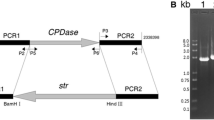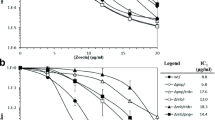Abstract
Orthologs of Escherichia coli ygjD and yeaZ genes are highly conserved in various organisms. The genome of the radioresistant bacterium Deinococcus radiodurans possesses single orthologs of ygjD (DR_0382) and yeaZ (DR_0756). Complete loss of either one or both genes did not result in any significant changes in cell growth efficiency, indicating that both genes are not essential for cell viability in D. radiodurans, unlike the case with other species such as E. coli, Bacillus subtilis and Saccharomyces cerevisiae. Survival rates following DNA damage induced by hydrogen peroxide (H2O2), N-methyl-N′-nitro-N-nitrosoguanidine (MNNG), ultra violet (UV) radiation, γ-rays, cisplatin and mitomycin C (MMC) were compared among the wild-type strain and D. radiodurans ygjD/yeaZ null mutants. Cell viability of the null mutants did not decrease following exposure to H2O2 or MNNG. In addition, the reduction in cell viability following exposure to γ-rays, UV radiation or cisplatin was marginal in the null mutants compared to the wild-type strain. Interestingly, the null mutants exhibited high sensitivity to MMC, which mainly causes interstrand DNA cross-links. The sensitivity of the null mutants to MMC was restored to that of the wild type by transformation with plasmids expressing these genes. These results suggest that D. radiodurans ygjD and yeaZ genes are involved in DNA repair and play a role in the repair of DNA cross-links.






Similar content being viewed by others
References
Abdullah KM, Lo RYC, Mellors A (1991) Cloning, nucleotide sequence, and expression of the Pasteurella haemolytica A1 glycoprotease gene. J Bacteriol 173:5597–5603
Abdullah KM, Udoh EKPEA, Shewen PE, Mellors A (1992) A neutral glycoprotease of Pasteurella haemolytica A1 specifically cleaves O-sialoglycoproteins. Infect Immun 60:56–62
Agostini HJ, Carroll JD, Minton KW (1996) Identification and characterization of uvrA, a DNA repair gene of Deinococcus radiodurans. J Bacteriol 178:6759–6765
Anderson AW, Nordan HC, Cain RF, Parrish G, Duggan D (1956) Studies on a radio-resistant Micrococcus. I. Isolation, morphology, cultural characteristics, and resistance to gamma radiation. Food Technol 10:575–577
Arigoni F, Talabot F, Peitsch M, Edgerton MD, Meldrum E, Allet E, Fish R, Jamotte T, Curchod ML, Loferer H (1998) A genome-based approach for the identification of essential bacterial genes. Nat Biotechnol 16:851–856
Aydin I, Saijo-Hamano Y, Namba K, Thomas C, Roujeinikova A (2011) Structural analysis of the essential resuscitation promoting factor YeaZ suggests a mechanism of nucleotide regulation through dimer reorganization. PLoS ONE 6:e23245
Battista JR (1997) Against all odds: the survival strategies of Deinococcus radiodurans. Annu Rev Microbiol 51:203–224
Bernstein K, Rothstein R (2009) At loose ends: resecting a double-strand break. Cell 137:807–810
Bizanek R, McGuinness BF, Nakanishi K, Tomasz M (1992) Isolation and structure of an intrastrand cross-link adduct of mitomycin C and DNA. Biochemistry 31:3084–3091
Blasius M, Sommer S, Hübscher U (2008) Deinococcus radiodurans: what belongs to the survival kit? Crit Rev Biochem Mol Biol 43:221–238
Daly MJ (2009) A new perspective on radiation resistance based on Deinococcus radiodurans. Nat Rev Microbiol 7:16–18
Deutsch C, El Yacoubi B, de Crécy-Lagard V, Iwata-Reuyl D (2012) Biosynthesis of threonylcarbamoyl adenosine (t6A), a universal tRNA nucleoside. J Biol Chem 287:13666–13673
Downey M, Houlsworth R, Maringele L, Rollie A, Brehme M, Galicia S, Guillard S, Partington M, Zubko MK, Krogan NJ, Emili A, Greenblatt JF, Harrington L, Lydall D, Durocher D (2006) A genome-wide screen identifies the evolutionarily conserved KEOPS complex as a telomere regulator. Cell 124:1155–1168
El Yacoubi B, Hatin I, Deutsch C, Kahveci T, Rousset JP, Iwata-Reuyl D, Murzin AG, Lagard VC (2011) A role for the universal Kae1/Qri7/YgjD (COG0533) family in tRNA modification. EMBO J 30:882–893
Fujikane R, Ishino S, Ishino Y, Forterre P (2010) Genetic analysis of DNA repair in the hyperthermophilic archaeon, Thermococcus kodakaraensis. Genes Genet Syst 85:243–257
Galperin MY, Koonin EV (2010) From complete genome sequence to ‘complete’ understanding? Trends Biotechnol 28:398–406
Griese M, Lange C, Soppa J (2011) Ploidy in cyanobacteria. FEMS Microbial Lett 323:124–131
Handford JI, Ize B, Buchanan G, Butland GP, Greenblatt J, Emili A, Palmer T (2009) Conserved network of proteins essential for bacterial viability. J Bacteriol 191:4732–4749
Hansen MT (1978) Multiplicity of genome equivalents in the radiation-resistant bacterium Micrococcus radiodurans. J Bacteriol 134:71–75
Harsojo, Kitayama S, Matsuyama A (1981) Genome multiplicity and radiation resistance in Micrococcus radiodurans. J Biochem 90:877–880
Hashimoto C, Sakaguchi K, Taniguchi Y, Honda H, Oshima T, Ogasawara N, Kato J (2011) Effects of transcription of mutants in ygjD, yeaZ and yjeE genes, which are involved in a universal tRNA modification in Escherichia coli. J Bacteriol 193:6075–6079
Hecker A, Leulliot N, Gadelle D, Graille M, Justome A, Dorlet P, Brochier C, Quevillon-Cheruel S, Cam EL, Tilbeurgh HV, Forterre P (2007) An archaeal orthologue of the universal protein Kae1 is an iron metalloprotein which exhibits atypical DNA-binding properties and apurinic-endonuclease activity in vitro. Nucleic Acids Res 35:6042–6051
Jiao J, Wang L, Xia W, Li M, Sun H, Xu G, Tian B, Hua Y (2012) Function and biochemical characterization of RecJ in Deinococcus radiodurans. DNA Repair 11:349–356
Karandashova I, Elanskaya I, Marin K, Vinnemeier J, Hagemann M (2002) Identification of genes essential for growth at high salt concentrations using salt-sensitive mutants of the cyanobacterium Synechocystis sp. strain PCC 6803. Curr Microbiol 44:184–188
Katz C, Cohen-Or I, Gophna U, Ron EZ (2010) The ubiquitous conserved glycopeptidase Gcp prevents accumulation of toxic glycated proteins. mBio 1:e0019510
Kisseleva-Romanova E, Lopreiato R, Baudin-Baillieu A, Rousselle JC, Ilan L, Hofmann K, Namane A, Mann C, Libri D (2006) Yeast homolog of a cancer-testis antigen defines a new transcription complex. EMBO J 25:3576–3585
Kitayama S, Narumi I, Funayama T, Watanabe H (2003) Cloning of structural gene of Deinococcus radiodurans UV-endonuclease β. Biosci Biotechnol Biochem 67:613–616
Lei T, Liang X, Yang J, Yan M, Zheng L, Walcheck B, Ji Y (2011) The C-terminal domain of the novel essential protein Gcp is critical for interaction with another essential protein YeaZ of Staphylococcus aureus. PLoS ONE 6:e20163
Meima ROB, Rothfuss HM, Gewin L (2001) Promoter cloning in the radioresistant bacterium Deinococcus radiodurans. J Bacteriol 183:3169–3175
Michel B, Boubakri H, Baharoglu Z, LeMasson M, Lestini R (2007) Recombination proteins and rescue of arrested replication forks. DNA Repair 6:967–980
Moseley BE, Copland HF (1978) Four mutants of Micrococcus radiodurans defective in the ability to repair DNA damaged by mitomycin-C, two of which have wild-type resistance to ultraviolet radiation. Mol Gen Genet 160:331–337
Naor A, Thiaville PC, Altman-Price N, Cohen-Or I, Allers T, de Crécy-Lagard V, Gophna U (2012) A genetic investigation of the KEOPS complex in halophilic archaea. PLoS ONE 7:e43013
Narumi I, Cherdchu K, Kitayama S, Watanabe H (1997) The Deinococcus radiodurans uvrA gene: identification of mutation sites in two mitomycin-sensitive strains and the first discovery of insertion sequence element from deinobacteria. Gene 198:115–126
Narumi I, Satoh K, Kikuchi M, Funayama T, Kitayama S, Yanagisawa T, Watanabe H, Yamamoto K (1999) Molecular analysis of the Deinococcus radiodurans recA locus and identification of a mutation site in a DNA repair-deficient mutant, rec30. Mutat Res 435:233–243
Oberto J, Breuil N, Hecker A, Farina F, Brochier-Armanet C, Culetto E, Forterre P (2009) Qri7/OSGEPL, the mitochondrial version of the universal Kae1/YgjD protein, is essential for mitochondrial genome maintenance. Nucleic Acids Res 37:5343–5352
Ohba H, Satoh K, Yanagisawa T, Narumi I (2005) The radiation responsive promoter of the Deinococcus radiodurans pprA gene. Gene 363:133–141
Rajagopala SV, Yamamoto N, Zweifel AE, Nakamichi T, Huang HK, Mendez-Rios JD, Franca-Koh J, Boorgula MP, Fujita K, Suzuki K, Hu JC, Wanner BL, Mori H, Uetz P (2010) The Escherichia coli K-12 ORFeome: a resource for comparative molecular microbiology. BMC Genomics 11:470
Satoh K, Ohba H, Sghaier H, Narumi I (2006) Down-regulation of radioresistance by LexA2 in Deinococcus radiodurans. Microbiology 152:3217–3226
Satoh K, Kikuchi M, Ishaque AM, Ohba H, Yamada M, Tejima K, Onodera T, Narumi I (2012) The role of Deinococcus radiodurans RecFOR proteins in homologous recombination. DNA Repair 11:410–418
Srinivasan M, Mehta P, Yu Y, Prugar E, Koonin EV, Karzai AW, Sternglanz R (2011) The highly conserved KEOPS/EKC complex is essential for a universal tRNA modification, t6A. EMBO J 30:873–881
Tanaka M, Narumi I, Funayama T, Kikuchi M, Watanabe H, Matsunaga T, Nikaido O, Yamamoto K (2005) Characterization of pathways dependent on the uvsE, uvrA1, or uvrA2 gene product for UV resistance in Deinococcus radiodurans. J Bacteriol 187:3693–3697
Tomasz M (1995) Mitomycin C: small, fast and deadly (but very selective). Chem Biol 2:575–579
Zalacain M, Biswas S, Ingraham KA, Ambrad J, Bryant A, Chalker AF, Iordanescu S, Fan J, Fan F, Lunsford RD, O’Dwyer K, Palmer LM, So C, Sylvester D, Volker C, Warren P, McDevitt D, Brown JR, Holmes DJ, Burnham MKR (2003) A global approach to identify novel broad-spectrum antibacterial targets among proteins of unknown function. J Mol Microbiol Biotechnol 6:109–126
Acknowledgments
I would like to thank Dr. Akira Nakamura, University of Tsukuba for the valuable comments and discussion about ygjD and yeaZ orthologs. I am also indebted to the members of Ion Beam Mutagenesis Research Group of JAEA, whose opinions and information have helped me very much throughout this study. This work was supported in partly by a Grant-in-Aid for Scientific Research (C) from the Japan Society for the Promotion of Science (JSPS) (grant no. 22580098 to I.N.) and by the JSPS Research Fellowship for Young Scientists (to T.O.).
Author information
Authors and Affiliations
Corresponding author
Additional information
Communicated by F. Robb.
Rights and permissions
About this article
Cite this article
Onodera, T., Satoh, K., Ohta, T. et al. Deinococcus radiodurans YgjD and YeaZ are involved in the repair of DNA cross-links. Extremophiles 17, 171–179 (2013). https://doi.org/10.1007/s00792-012-0506-4
Received:
Accepted:
Published:
Issue Date:
DOI: https://doi.org/10.1007/s00792-012-0506-4




